Folks are building houses and retrofitting existing houses with increased airtightness, and this is great. They use a blower door to help measure leakage, and this is also great. But then they think that a blower door actually is a precise measuring tool for how air will leak across the building during service. Wrong. Even more serious an issue is to then take the leap that using a wrong assumption about the results of an approximate measurement can be used to decide that mechanical ventilation is not needed. Bad, very bad, and potentially deadly.
A blower door measures a characteristic of the house, not the leakage rate of the house in service.
You can’t use a blower door to determine air change rates because a blower door does not give you the distribution of holes, and if you don’t know the distribution of holes, you can’t determine the pressure differences across them during service. If you don’t know both the distribution of holes and the pressure differences across them, you don’t know jack.1 Never mind that I love blower doors, and that I use them all of the time. Read on.
When someone puts a decimal place into a blower door-determined air change rate after a whole bunch of computer-assisted numerical manipulation, and proclaims that the interior environment in a house is safe without a ventilation system and without a provision for combustion air, I usually go have a bourbon because it tends to be more satisfying than getting a gun. I view these folks as little more than charlatans who run around for the sake of the show, rather than providing value to the process. If you are using a blower door for this reason, it makes more sense to take the money spent on the tester and the blower door and spend it on a ventilation system and combustion safety.2 I know I won’t win this argument because there is too much money involved in the show and managing the show, but I can get satisfaction in calling something “bull#@%!” when I see it.
Blower doors measure equivalent leakage area. Not the real leakage area and not the real leakage paths and certainly not the distribution of the real leakage area and the real leakage paths. Everything is sort of combined into a single near meaningless value. Not a meaningless value, but a near meaningless value. The real meaning, in my not so humble opinion, is that it can tell you when you get rid of the big holes3 and that is where I am going with this. We are going to focus on big holes and a great use for a blower door.
Blower doors are a quality control thing. But they are not the only quality control thing. They are one of many. And they are not always necessary despite what folks say. What they are not is a quality assurance thing. The difference is important. Quality assurance is figuring out what the right thing to do is; quality control is doing it. For example, the right thing to do is to “build tight and ventilate right.” Blower doors can help measure the “tight” part. They cannot measure the “ventilate right” part.
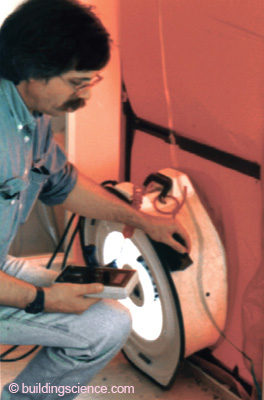
Photograph 1: The Ubiquitous Blower Door—I love what it can do and hate what it can’t do even though people say that it can. That is pretty clear, isn’t it?
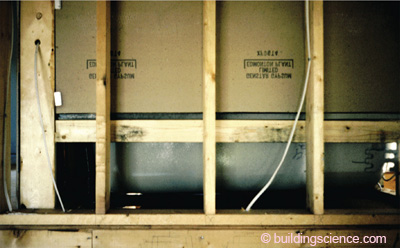
Photograph 2: Bathtub on Exterior Wall—The classic “Joe Hole”—a hole so big even I can crawl through it. It needs to be draftstopped with something rigid and airtight. Note to folks out there in the real world: fluffy insulation is not rigid and airtight. But a sheet of OSB or gypsum board over fluffy insulation makes the fluffy insulation happy and Joe happy.
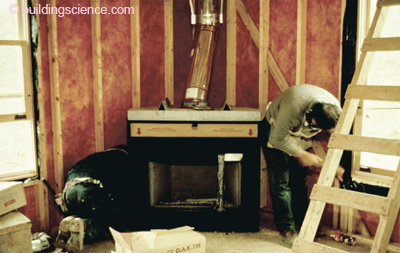
Photograph 3: Fireplace on Exterior Wall—OK, an even bigger hole than the bathtub hole. Kind of makes it funny to think about sealing an electrical wire going through a top plate when you have something this big.
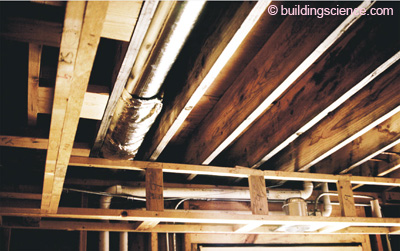
Photograph 4: Soffit on Exterior Wall—Wow, this allows for connecting your entire floor cavity to the outside.
To me, the ventilate right part is easy: put in a ventilation system and pick a rate.4 A ventilation system is more reliable than any other approach—such as building a leaky building with random uncontrolled holes. And in terms of the rate, let the people in the house pick the rate much like we do with letting people pick a temperature. We give them a system that can satisfy a range of conditions, and then we give them control of the thermostat. I say we do the same with a ventilation stat.
So how tight should we go? Depends on who you ask and whether or not they are crazy.5
Back in the day, when I was young and didn’t know what I didn’t know and what I could never know,6 I was asked to establish airtightness limits and create a ventilation standard for new, to be constructed, energy-efficient houses in Canada. I was supposed to put something together called the R-2000 Program. The year was 1982. Where to start? Easy. Ask someone who knows more than you. Back then, everyone knew more than me. I went to the National Research Council of Canada and ran into folks with names like Handegord, Wilson, Baker, Tamura, Shaw, Bomberg, among others. They said: “interesting that you ask, we have been measuring things and talking to the Swedes who not only are measuring things, but they have actually got something called a “code” for this kind of stuff. It seems that most new houses with basements that we have measured in Canada (and that some other folks have been measuring in the northern U.S.) are around five to seven air changes per hour at a 50 Pa air pressure difference (ach@50Pa) when tested with a pressurization test.” I said what is a pressurization test? And you can guess the rest.
It turns out that the Swedes figured out that when they got rid of the big holes in their houses it was pretty easy to get below 3 ach@50 Pa. The Swedes, being Swedes, put that value right into their building code.
My problem with the 3 ach@50 Pa was that it was Swedish. Actually, it wasn’t my problem; the 3 ach@50 Pa was a problem for a bunch of folks in Saskatoon, SK, who had just finished building around 10 ultratight ugly boxes that passed for houses. Recall the year was 1982. These 10 ultratight ugly boxes (did I mention that they were ugly and boxes?) were hermetically sealed in plastic and had double walls and lots of other stuff that seemed pretty strange to me. Anyway, these houses were all just below 1 ach@50 Pa.
So, the Saskatoon Mafia pushed 1 ach@50 Pa as the national standard for this national program. I thought, you have got to be kidding, right? A sample size of 10 weird houses constructed in Saskatoon is going to set a national standard? Hey, we were Canadians, not Swedes, why bother to measure enough stuff to get a representative sample when you are a true believer? I said let’s pick 2 ach@50 Pa, which was a wild ass guess (WAG). I pointed out that even the Swedes, who build houses like they build furniture, picked 3 ach@50 Pa for their national standard. I figured that we could do better than the Swedes, but not that much better. I mean, we regularly beat the Swedes at hockey, so we should be able to do it with building tightness, right? That argument was actually more logical than any other argument presented at the time. I pushed back hard, but not hard enough, the Saskatoon Mafia were well connected, and we ended up with 1.5 ach@50 Pa as a compromise for the national program called R-2000.
Problem was, nobody outside of Saskatoon had ever constructed appreciable numbers of houses at 1.5 ach@50 Pa. Under the test phase/demonstration phase of the program we constructed about 20 test houses with real builders in different provinces and found that it was very, very difficult to get to 1.5 ach@50 Pa in houses that looked like a house someone would actually want to live in, unless they lived in Saskatoon. Did I mention that it was very, very difficult?
I thought establishing 1.5 ach@50 Pa as a standard was going to be a train wreck because the number was too low for production builders to achieve, and the R-2000 program would become a “boutique program” that would garner all kinds of press but not do much in terms of number of houses actually constructed. I was proven right. Sorry, fellow Canadians. It was the wrong num•ber at the wrong time. It still is.
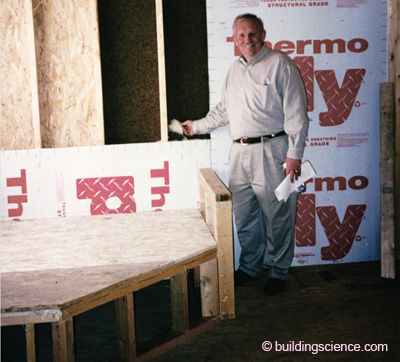
Photograph 5: Effective Draftstopping—Notice the rigid material behind the large soaking tub/whirlpool framing on the exterior wall. Notice the rigid material going up the exterior wall where the shower is going to be. Notice the big smile on the VP of construction for a major, major production home builder in Chicagoland. No comfort complaints for him anymore because there are no big holes.

Photograph 6: Tub on Exterior Wall Before Tub Installation—Notice the rigid material on the exterior wall where the one-piece shower/tub thingy is going to be.
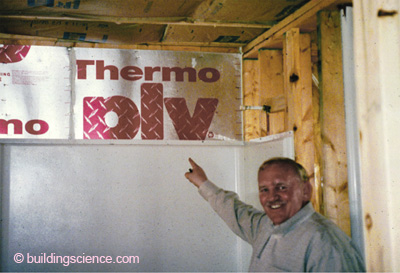
Photograph 7: Tub on Exterior Wall After Tub Installation—Notice the rigid material on the exterior wall behind where the one-piece shower/tub thingy is. Notice the even bigger smile on that VP of construction.
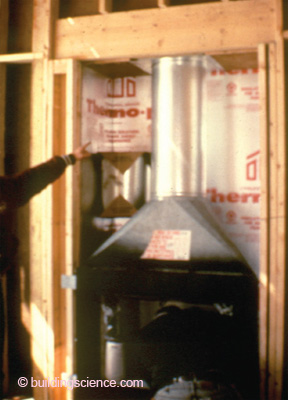
Photograph 8: Draftstopped Fireplace—Pretty easy to get right if you know this is a really big hole. The draftstop makes the fireplace work even better because the fireplace is also warmer. Warm fireplaces draft better. Warm chimneys draft even better.
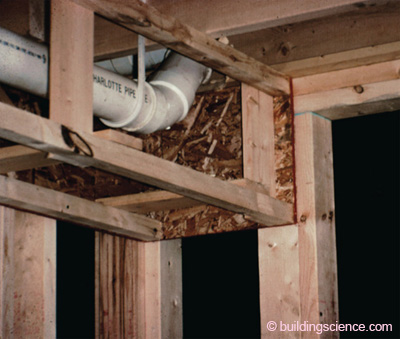
Photograph 9: Draftstopped Soffit—’Nuff said.
Anyway, nothing much happened over the next decade, and R-2000 fizzled out. I came to the U.S. to seek my fortune and got involved with a few big builders. Folks who built 20,000 to 30,000 houses a year each. It turns out that a bunch of the big U.S. builders had comfort complaints because they were building houses with big holes. I figured I knew about holes and I was off to the races. The good news was there was no standard so I could make one up. I had already had experience about how to make things up.
I picked one of the big builders’ worst divisions in terms of comfort complaints—it turned out to be Chicago—and focused on making the comfort complaints go away. Notice, energy had nothing to do with any of this. I figured that if they got rid of the big holes the comfort problems would go away. The list of big holes was pretty easy to compile. Bathtubs on exterior walls, fireplaces and chimneys on exterior walls, garages attached to houses with bedrooms over them, cantilevered second floors, interior soffits dead ending into exterior walls and dropped ceilings under attic insulation. Done. Make these go away with draftstopping and, presto, the comfort problems would go away.
In one year we did a thousand houses and, sure enough, the comfort problems went away. I measured a lot of stuff with blower doors, and the houses were coming in at around 3 ach@50 Pa—consistently. Apparently, the Swedes had been on to something. I wasn’t completely dumb by then and made sure that every house had a controlled ventilation system and made sure that all the gas furnaces and gas water heaters had combustion air and that we had tight return systems so we didn’t back draft anything. It became even easier when we started specifying sealed combustion 90 plus gas furnaces and power vented water heaters.
Then it got even better. The utility bills dropped big time. I started tracking them, and it became pretty easy to predict them, especially when you could get your hands on a thousand of them in houses built in a similar way that you more or less had control over. You know where this led—a utility bill guarantee program and marketing heaven. And in a real sweet twist, a comfort guarantee was added as well. Bottom line, if you get below 3 ach@50 Pa the comfort problems go away, things become predictable, and you save energy. Add the controlled ventilation piece and the combustion safety piece and nobody dies and nobody gets sick and life is good.7
It got even better. The Building America Program came along and focused on production housing, not boutique housing. Guess what the airtightness number for Building America more or less became? Yup, 3 ach@50. Then Sam Rashkin8 came along with EPA’s ENERGY STAR® and got his hands on the “big holes list,” which became the “thermal bypass list” and things began to really happen. You could actually do this on large numbers of houses. You could actually do a “code change thing” and get folks on board if you had a track record and lots of houses under your belt. Well, it is happening—and without a major food fight. The codes are going to go to 3 ach@50 Pa and 5 ach@50 Pa, depending on where you are. This is good.
But, the true believers are never happy because 3 ach@50 Pa is too high for them; 1.5 ach@50 Pa is the number for them. After all, the argument goes, the Canadians did it. Well, actually no. We did it on a ridiculously low number of houses because it is really hard to do, and quite frankly, not worth it, especially if you then overventilate the houses—not even an HRV can save you. New Canadian houses are now pretty tight—less than 3 ach@50 Pa—getting close to 2 ach @50 Pa, but not 1.5 ach@50 Pa; and the houses are overventilated, so we don’t actually save that much energy.9
The true believers are a fun, well-meaning bunch, and I tend to get along with them. I invite them to my parties, but I have yet to be invited to one of theirs. Apparently, there is a message there. It could be my personality. On our custom home stuff we get to 1.5 ach@50, but it is a lot of work.
The group that really has me confused are the PassivHaus folks who are pushing 0.6 ach@50Pa. Yes, that is the number. It comes from Germany, so it must be right.
Have you any idea how difficult it is to get to 0.6 ach@50 Pa? The number doesn’t seem to be based on anything that makes any sense. It is less than half the R-2000 number that didn’t make any sense. What I have been more or less able to figure out is that the 0.6 ach@50 Pa doesn’t come from any energy conservation rationale directly; it seems to be based on the need to prevent moisture problems in highly insulated building enclosures. That is the argument for the number 0.6 ach@50 Pa as I understand it. Never mind that that the number, in itself, makes no sense as you can easily design highly insulated building closures without moisture problems that are not anywhere that tight.
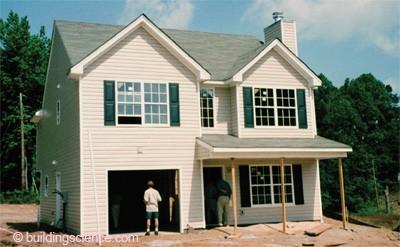
Photograph 10: Bedroom Over Garage—Unfortunately, in my experience, garages are not effectively isolated from houses, especially at the second floor assembly to interior garage perimeter.
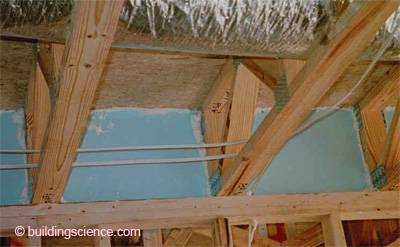
Photograph 11: Bedroom Over Garage Done Well—Notice how beautifully the floor joists are draftstopped over the top of the wall that separates the interior garage perimeter from the house. This location typically represents a huge leakage area (aka, big holes).
So why should I care? Or why should we care? From my own personal perspective you should be able to pick any number you want. And hats off to the PassivHaus folks for their own personal program number. It is their program, and they get to do what they want as far as I am concerned. I only get irritated when they criticize everyone else. This big old mangy junkyard dog of an engineer tends to bark back when criticized, and I bark back even louder when my friends get criticized, especially on stuff that is arbitrary and capricious. And arbitrary and capricious is OK too—in your own personal program and your own personal life—but not in mine. Public policy and national standards should not be arbitrary and capricious.
That brings us back to the beginning more or less. Big holes, blower doors, tightness limits, ventilation, ventilation rates, combustion safety and public policy as opposed to private policy.
So, from a public policy and national standard perspective, in my opinion, get rid of the big holes, provide a ventilation system and ensure combustion safety and call it a day. Getting rid of the big holes means less than 3 ach@50 Pa as measured with a blower door. That is what a blower door is good for. Don’t use a blower door to assess acceptable indoor air quality because the approach is not reliable.
What is the best way of providing acceptable indoor air quality and ensuring combustion safety? Easy. Install a controlled ventilation system. Start with ASHRAE Standard 62.2 recommended rates and add some slack and then turn things down and give control and responsibility to the folks in the house. Install sealed combustion or power vented appliances. Let me repeat that last part: install sealed combustion or power vented appliances.
What is the next best way? Follow the combustion safety provisions of the building codes—they have it right—but installing sealed combustion or power vented appliances is even better. And don’t forget about this controlled ventilation thing.
What is the worst way? Tightening up a house to an arbitrary and capricious value established just for the purpose of avoiding having to install a ventilation system and avoiding having to meet the combustion safety provisions of the building code, but making it look technically sound because a geek with a blower door did a test. Apparently, there is a lot of money in testing, but not so much in fixing the actual problem.
What is the next worst way? Tightening up a house to an arbitrary and capricious value that is almost impossible to achieve and then overventilating it. If I had a choice, between these two, I would choose the latter, of course. But what a choice.
I think, maybe, Goldilocks had it right, not too leaky, not too tight, just right. Then, add controlled ventilation, but not too much, not too little, just right. And, of course, sealed combustion and power vented all around.
Foonotes:
I have always wondered who “Jack” was. Turns out it is not a “who,” but a “what”: “a trifling, infinitesimal amount.” The other word that usually follows “jack” does not need to be defined as most folks already know what it is and some of us can recognize it.
You can install a ventilation system and code-compliant combustion air for less than $500, which is about the cost of a blower door test. Then, you don’t need to do the blower door test and the computer-assisted numerical masturbation.
For the folks who say you need a blower door to find the big holes I also say “bull“#@%!” Give me an experienced contractor and I will match them against a geek with a blower door any day. And when you find a big hole and fix it you don’t need a blower door to tell you that you fixed it. Take a picture of the fix and put it in a file. There is your proof, if you need proof. Most of the time I spend with blower door geeks consists of explaining to them how come they haven’t found the big hole yet and where it actually is.
Our approach is to design and install a controlled ventilation system that is capable of ventilating at 1.5 times the current ASHRAE Standard 62.2 recommended rate, commissioning the system at 60% of the current ASHRAE Standard 62.2 recommended rate and giving control of the ventilation system to the occupant and telling them they can turn it up, turn it down or turn it off. They are responsible for their own environment. This personal responsibility thing is big with us. Of course, there are folks who want to control your thermostat, and folks who are going to want to control your ventilation stat. I say, we hunt these people down and get them out of the gene pool. Just my opinion, mind you. Apparently, elections have consequences. Before I get a zillion comments, I know it is not quite the same. Most of us know that there is a safe range for temperature: don’t turn off the heat completely as things will freeze. Also, most of us can sense temperature; we know when it is too hot and when it is too cold. Ventilation is a little bit different. It can be argued that most people don’t know when they have enough ventilation or when they have too little. I like ranges. A range of ventilation rates that fit between the bookends of too much and too little. We can set the “bookends” from a policy perspective and then get out of folks’ way.
A sort of Rumsfeldism. It will be interesting to see how history treats him in 50 years time—and his boss, too.
Houses without controlled ventilation systems are subject to increased levels of contaminants as airtightness goes up. Houses with standard atmospherically coupled combustion appliances without provision for dedicated combustion air are subject to back drafting and spillage as airtightness goes up. Controlled ventilation and combustion safety are not only good, but necessary.
You all have no idea of the grief Sam took initially with all of this. Lucky for us, he stuck with it. Good job, Sam. Here is the link to the checklist and have at it: http://tinyurl.com/thermalbypasslist.
But hey, we have lots of energy up in Canada. So much so, we want to sell it to you if you would only let us build that pipeline to you from the oil sands, so we can afford to overventilate. If you won’t let us build the pipeline to you, we will just sell the stuff to the Chinese. They at least can afford to buy it. Either way we get the money to subsidize our heath-care plan. You know the one. The one that is very expensive with the long lines. Ah, I hear you are getting one of those, too. Actually, the U.S. spends more per capita on health care than Canada does and has a lower life expectancy. Maybe those lines aren’t so bad, eh?
